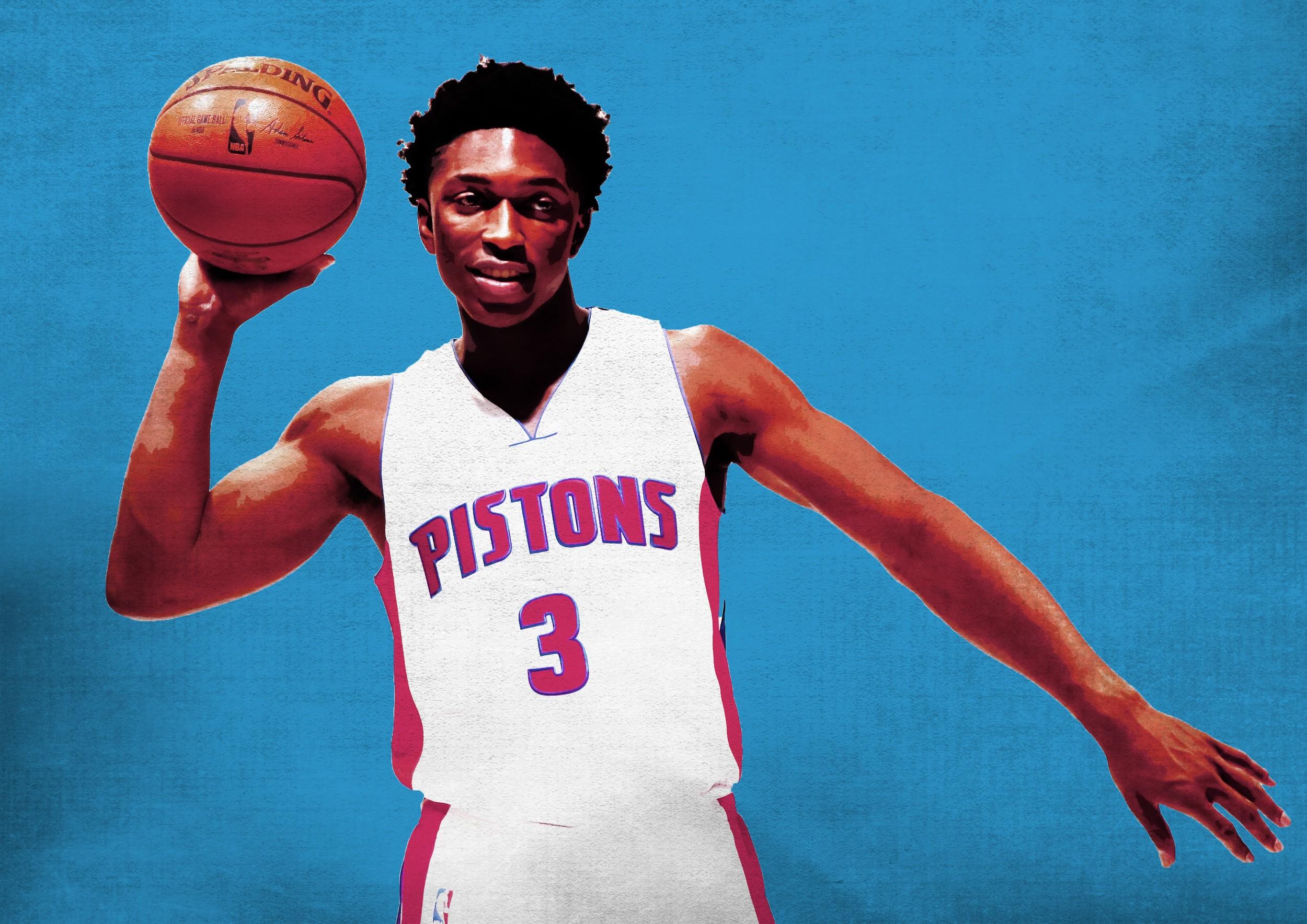
It’s been only a season, but the 2015 NBA draft class seems destined to be one of the best ever. Even beyond clear superstar talents like Karl-Anthony Towns and Kristaps Porzingis, the class is teeming with players who, in one way or another, serve as a key to understanding their respective teams’ long-term identity. Over the next few weeks, Jonathan Tjarks will be looking at 2015 draftees entering Year 2, and how their teams can best serve their pillars of the future.
Stanley Johnson doesn’t lack for confidence. Most rookies would have dreaded a matchup with LeBron James in their playoff debut. Johnson seemed to relish it. He boasted about being in LeBron’s head during the Pistons’ first-round series against the Cavs; he followed that up by saying LeBron only talks trash when his teams are winning, and that he had no reason to be scared of James. The Pistons were swept, but the games themselves were competitive, and Johnson was in the thick of things, mixing it up with LeBron.
What makes Johnson an intriguing prospect is that he has the body to make that possible. Most players bounce off LeBron like flies on a windshield. Johnson’s sturdy build was enough to hold position against one of the strongest forwards in NBA history. At 6-foot-7 and 245 pounds with a 6-foot-11 wingspan, he is a 20-year-old with the body of a Greek sculpture. LeBron couldn’t bulldoze him in the same way that he can most defenders. The Pistons were the only team to hold James under 50 percent from the field for an entire series in last year’s playoffs.
Detroit was the team standing in LeBron’s way in his first stint with Cleveland, and now, a decade later, the situation is reversed. The two Central Division rivals could be facing off against each other in the playoffs for years to come, and the Pistons will need Johnson to maximize every bit of his potential if they are going to dethrone the King. To get a feel for where he is in his development, I broke down the film from three games from his rookie season — one of his worst performances and one of his best, as well as his play in the Pistons’ most important game of the season, their Game 4 loss to the Cavs.
January 9 vs. Brooklyn — Eight points, four rebounds, one assist, one block, and two steals on 4-of-13 shooting
An injury to Marcus Morris put Johnson in the starting lineup at small forward, where he guarded Joe Johnson. Despite being in his mid-30s, Joe Johnson’s strength, guile, and shooting ability makes him one of the toughest covers in the NBA, even as his athleticism has faded. The older Johnson loves to put smaller defenders on his back and bully them in the post, but the younger Johnson pushed him out of the paint and forced him to initiate offense near the 3-point line. Defense is as much mental as it is physical, though, and Joe was repeatedly able to use pump-fakes to get Stanley out of position and knock down open shots.
The real problems came on offense, where Stanley Johnson was mostly spotting up off the ball, instead of getting chances to create plays on the second unit. Playing without the ball in your hands is a huge adjustment for many young players, especially those without a consistent outside shot.
It was difficult for Johnson to get his defender to overcommit when he missed all five of his attempts from the 3-point line, and he shot only 30.7 percent from beyond the arc as a rookie. Defenses are going to give him space on the perimeter until he proves he can make it.
February 4 vs. New York — 22 points, nine rebounds, five assists, two steals, one block, and two turnovers on 7-of-12 shooting
Johnson’s next game against a team from the Big Apple went much smoother. This time he was starting in place of Kentavious Caldwell-Pope at shooting guard, a role which gave him a lot more freedom on offense. The Pistons allowed him to run pick-and-rolls with Drummond, and he looked the part of a point forward, with the dribbling and passing ability to create shots for himself and others. Once he made his first few outside shots and forced the Knicks to guard him on the perimeter, he overwhelmed defenders with his physicality to get easy points around the rim.
For young players with the kind of clear strengths and weaknesses that Johnson has, the best thing a team can do is to put players in positions where they can exploit preferable matchups. Detroit playing Johnson at the 2 meant he was mostly guarded by Arron Afflalo, who is shorter and gives up a significant amount in bulk, as opposed to Carmelo Anthony, who is more or less the same size. Asking Afflalo, standing 6-foot-5 and 210 pounds, to guard a bruiser like Johnson, who is bigger than some power forwards in the league, is a recipe for disaster. Johnson’s imposing play was seen through his extended stay at the charity stripe against the Knicks, going 7-of-8 from the free throw line.
April 24 vs. Cleveland — Five points, five rebounds, one steal, and one turnover on 2-of-8 shooting
Johnson didn’t get the chance to do much on offense in the playoffs. He had his hands full against LeBron, and he was, at best, the sixth option behind Reggie Jackson, Caldwell-Pope, Morris, Andre Drummond, and Tobias Harris. The encouraging part about his performance in this series was his efficiency in a smaller role, averaging 8 points a game on 52.2 percent shooting. He picked his spots well, moving the ball and not forcing up tough shots when they weren’t there. It’s hard to take away too much from such a limited sample size, but he definitely wasn’t scared of the moment, like a lot of young players would have been.
The most intriguing part of Game 4 was the Pistons’ closing lineup, in which they benched Drummond and played with five perimeter players in a replica of the Warriors’ Lineup of Death.
Johnson is the team’s player that most resembles Draymond Green in that scenario. He has a similar build, as well as the potential to guard multiple positions and make plays off the dribble. He gives up a few inches in wingspan compared to Green, so he’s not as well equipped to protect the rim, but the Pistons will need him to handle a similar load in terms of rebounding and switching screens if they are going to play super small next season.

Johnson’s ability to shift up or down the lineup depending on matchups allowed the Pistons to use him like a Swiss army knife as a rookie, but just because a player is versatile doesn’t mean he does everything well. He’s not a pure perimeter player, and he’s most effective as a power wing, which is becoming the most important position in the NBA. Think of guys like LeBron, Carmelo Anthony, Kevin Durant, and Kawhi Leonard, who warp the dynamic of the game when they move from the 3 to the 4, forcing the rest of the chessboard to adjust to them.
For a spread pick-and-roll team like the Pistons, the 2 through 4 positions have similar responsibilities. The main difference is size, not skill, at each position. Johnson is most effective when he has a physical advantage, either at shooting guard, where he’s bigger than most opponents, or at power forward, where he’s faster. When he’s playing at small forward, and going up against power wings who are just as strong and mobile as he is, he’s just another guy. The least effective pairing for Johnson as a rookie was with Ersan Ilyasova, a stretch power forward, and the Pistons had a net rating of minus-10 when the two played together. Compare that with their net rating of plus-29.1 in the playoffs when Johnson played with Harris, a fellow combo forward whom they acquired for Ilyasova in a trade at the deadline.
It’s all about matchups. Traditional big men could guard Ilyasova without much fear of him taking them off the dribble; this allowed the best wing defender on the opposing team the freedom to guard Johnson. But teams have to account for Harris both as a perimeter threat and a slasher when he’s in the game, which forces a slower defender on Johnson, whether it’s a big man or the opposition’s second-best wing defender. When he’s playing with Harris and Morris, he’s facing the other team’s third-best wing defender. Playing that many power wings together creates a domino effect with mismatches all over the floor, which will put Johnson in more positions to succeed next season. He talks a grown-man game, but he still needs time to develop into himself. Just because he’s ready to guard LeBron, it doesn’t mean he’s ready for LeBron to guard him.

